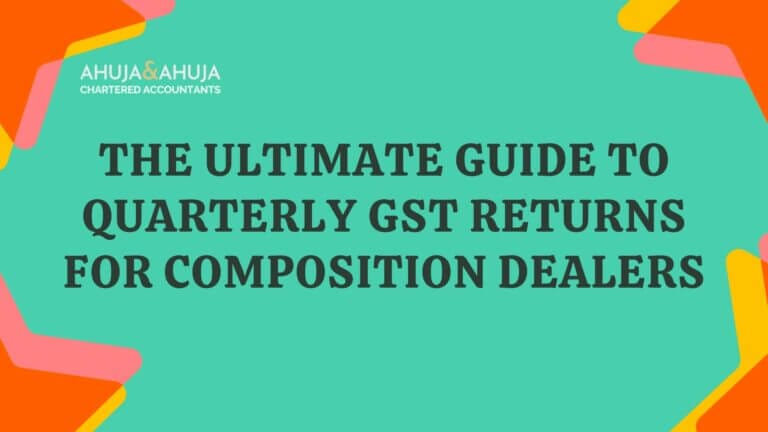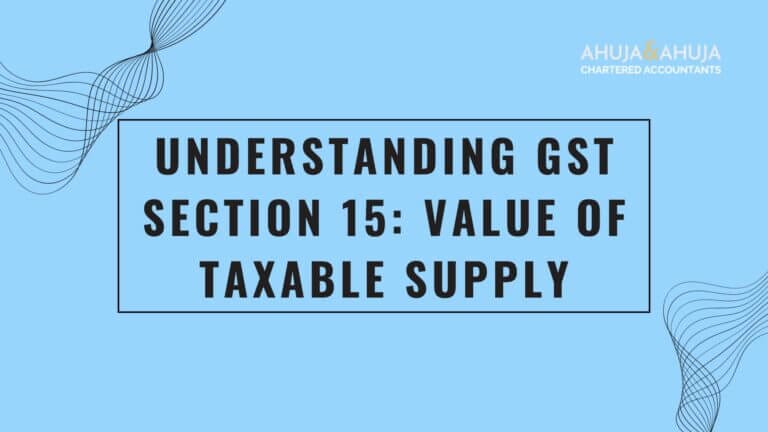A Guide to Mandatory Bank Details Submission in GST Compliance
The world of Goods and Services Tax (GST) consistently evolves, with new advisories and regulations continually emerging. Such changes necessitate attentive understanding and prompt action from taxpayers, which is where expert advice from experienced professionals, such as Ahuja and Ahuja, Chartered Accountants in Noida, becomes invaluable.
A recent critical advisory under this ever-evolving framework is Rule 10A of the Central Goods and Services Tax Rules, 2017, issued on 23/01/2024. This directive necessitates all registered taxpayers to furnish their bank account details within specific timelines—either within 30 days of their registration grant or before the due date of filing GSTR-1/IFF, depending on which comes earlier.
This article serves as a comprehensive guide aimed at elucidating the implications of this new rule, its requirements, consequences of non-compliance, the soon-to-be-deployed functionality, and steps towards efficient compliance with the directive. Whether you are a budding entrepreneur in need of business registrations or an established business owner, this guide will assist you in navigating through the complexities of the latest advisory, helping you conform appropriately and avoid adverse consequences.
The Legal Requirement: Mandatory Bank Details Submission
As we delve deeper into the practicalities of the advisory, it is crucial to understand that the submission of bank account details isn’t just a procedural step but a legal one. In the context of GST compliance, this new mandate carries a weight of authority under Rule 10A of the CGST Rules, 2017.
This rule insists on the importance of furnishing accurate bank account details for all registered taxpayers. These details serve as an essential link between tax compliance and financial transactions, forming a transparent and accountable tax administration system. The legal stipulation is clear: taxpayers must provide the details of their bank account/s within the stipulated 30-day period post-registration or before the deadline for filing their GSTR-1/IFF, whichever milestone occurs first.
This timeline is non-negotiable, and as a registered taxpayer, you must heed this schedule meticulously. For businesses in Greater Noida, it is imperative to seek thorough guidance from Chartered Accountants in Greater Noida to ensure all aspects of this new rule are understood and implemented within the given timeframe.
In the next segment, we will address the urgency of compliance and the risks associated with delay or non-compliance.
The Implication of Non-submission: Consequences and Risks
Time is of the essence when complying with the advisory for bank details submission. Let’s illuminate why swift action is not merely beneficial but critical. Taxpayers who have not yet complied, especially those approaching the end of their 30-day window, face significant repercussions that can impede their business operations.
Should this critical period lapse without action, registrants will confront a stark reality: their GSTIN (Goods and Services Tax Identification Number) will be subject to suspension. Such a suspension not only disrupts normal business activities but also signals the onset of a domino effect of regulatory obstacles, which starts with disablement of the e-way bill generation facility. It is a situation any business would find highly undesirable.
The new functionality, which is imminent in its rollout, would result in a twofold consequence for non-compliant taxpayers. Firstly, their registration faces suspension, and they will receive an intimation through FORM REG-31. Secondly, and more severe, they would be barred from filing subsequent GSTR-1/IFF, which could hinder their ability to conduct regular business transactions and lead to further financial uncertainties.
To underline the gravity of this situation, it is worth mentioning that a suspended GSTIN is more than an operational hurdle; it can lead to question marks over the credibility of your business in the eyes of stakeholders and potential partners. Your promptitude in updating your bank details can, therefore, safeguard not only your compliance status but also your commercial reputation.
Upcoming Functionality: Understanding its Features and Consequences
In response to the mandate, the GST Council is introducing a new functionality that underscores the administration’s commitment to compliance and its move towards a seamless and digitized tax environment. This functionality is equipped with features designed to enforce the directive sternly but justly, applying automated processes to minimize human errors and delays.
The features can be outlined as follows:
- Automated Suspension: Upon the lapse of the 30-day period without the submission of bank account details, an automated suspension of the taxpayer’s registration will be triggered, leading to immediate issuance of FORM REG-31.
- Debarment from Return Filing: Concurrent with suspension, the taxpayer will be barred from filing GSTR-1/IFF, thereby preventing any further tax submissions until compliance is achieved.
The consequences of failing to furnish bank details within the given timeframe are not to be underestimated. Once the suspension is in place, the taxpayer is put on the back foot, necessitating immediate corrective action to restore their GSTIN and return to normal business operations.
Understanding and navigating through this functionality may require expert assistance. As such, it would be advisable for taxpayers to seek help from chartered accountants or consultants who are well-versed with GST compliances and digital systems. These professionals can offer necessary guidance and support to ensure smooth and timely adherence to these new regulatory requirements.
Revocation of Suspension Process
Let’s explore the critical juncture where non-compliance has led to suspension, and what a registered taxpayer can do to reverse it. The GST portal will automatically issue a suspension of your registration, but it also provides a lifeline in the form of FORM REG-31. This form is essentially an official intimation and a clear signal for you to act without further delay.
Upon receipt of FORM REG-31, taxpayers have the opportunity to update their bank account details within a stipulated time. It is essential for compliance and reinstatement of the GSTIN to ensure that all the required bank details are properly updated on the GST portal.
The system is designed to be responsive such that when the required information, as prompted by FORM REG-31, is provided, the suspension of the GSTIN will be automatically revoked. This reinstates the taxpayer’s status back to ‘active’, allowing them to resume filing returns and other necessary compliance measures within the GST framework.
However, taxpayers should be acutely aware that if they fall short of updating the bank account details within 30 days of the issuance of FORM REG-31, they could face the grim prospect of having their registration cancelled. This action is not just disruptive, but it sets in motion a much more arduous process of reapplication and potential scrutiny by tax authorities.
The mechanism in place aims to be corrective rather than punitive, providing taxpayers every chance to rectify their status. That said, it underscores the seriousness of adhering to compliance measures set forth by the tax authorities and the risks associated with disregarding them.
Efficient Compliance: Actionable Advice for Taxpayers
Ensuring compliance with the GST norms regarding bank account details submission need not be a daunting task. To help taxpayers navigate this requirement efficiently, here is a compilation of actionable advice:
- Timely Submission: Do not wait until the deadline approaches. Proactively submit your bank account details soon after obtaining your GST registration.
- Accuracy of Information: Verify the accuracy of all bank details before submission. Inaccurate or incomplete information could lead to unnecessary complications.
- Consult Experts: If unsure about the process, consider consulting with GST experts or Chartered Accountants who specialize in GST regulations and can offer bespoke assistance.
- Regular Monitoring: Keep a close eye on any communication from the GST Council or related authorities. Regular monitoring of your GSTIN status on the GST portal will alert you to any pending compliance requirements or notifications such as FORM REG-31.
- Leverage Technology: Utilize the automation and alerts provided by financial management software and GST compliance tools, which can remind you of significant deadlines and regulatory changes.
- Documentation and Records: Maintain proper documentation of your GST compliance processes, including the submission of bank details. This can act as evidence of compliance if required in the future.
- Educate Your Team: Ensure that the finance and taxation teams in your organization are well-informed about GST compliances and latest advisories. Continuous education on updates and changes in regulations can help in preventing oversights.
By following these steps, taxpayers can steer clear of any non-compliance issues, thereby ensuring a steadier business operation without interruptions due to regulatory roadblocks.
Frequently Asked Questions (FAQs)
To enhance understanding and provide clarity on the advisory regarding mandatory bank details submission in GST, let’s address some common questions:
Who is required to furnish bank details as per the latest GST advisory?
All registered taxpayers under GST must furnish their bank account details. This includes new registrants who have to provide this information within 30 days of registration or before the due date of their first GSTR-1/IFF filing, whichever comes first.
What happens if I fail to submit my bank account details within the required timeframe?
Failure to submit bank account details within the specified timeframe will result in an automatic suspension of GSTIN and debarring the taxpayer from filing GSTR-1/IFF.
How will I be informed of my GSTIN suspension?
You will receive an intimation of suspension in the form of FORM REG-31 from the GST portal.
Can I get my GSTIN reinstated after suspension due to non-submission of bank details?
Yes, your GSTIN can be reinstated. The suspension will be automatically revoked upon updating your bank account details in response to FORM REG-31.
What is the risk involved if I do not update my bank details even after receiving FORM REG-31?
If you do not update your bank details within 30 days of the issuance of FORM REG-31, the process for cancellation of your registration may be initiated by the tax officer.
How can I provide my bank account details to the GST authorities?
You can log in to the GST portal and enter your bank account details in the specified section. For exact navigation, it’s best to consult GST help documentation or speak to a GST advisor.
Is it possible to update bank details after the registration is suspended?
Yes, you can still update your bank details after suspension. Once updated, the suspension will be revoked, subject to compliance within the time limit set from the date of FORM REG-31 issuance.
Where can I find assistance for complying with this advisory?
Chartered Accountants and GST experts can provide assistance in understanding and complying with this directive. Professional services are recommended, particularly if you are close to the deadline or have already received a suspension notice.
Disclaimer
The materials provided herein are solely for educational and informational purposes. No attorney/professional-client relationship is created when you access or use the site or the materials. The information presented on this site does not constitute legal or professional advice and should not be relied upon for such purposes or used as a substitute for professional or legal advice.







